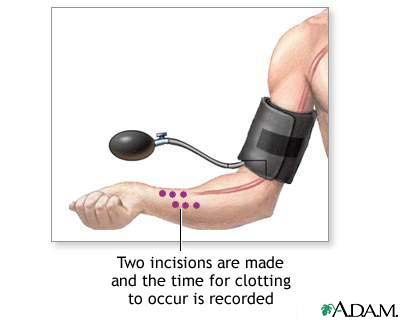Health Library
Bleeding time
Bleeding time is a medical test that measures how fast small blood vessels in the skin stop bleeding.
Images

I Would Like to Learn About:
How the Test is Performed
A blood pressure cuff is inflated around your upper arm. While the cuff is on your arm, the health care provider makes two small cuts on the lower arm. They are just deep enough to cause a tiny amount of bleeding.
The blood pressure cuff is immediately deflated. Blotting paper is touched to the cuts every 30 seconds until the bleeding stops. The provider records the time it takes for the cuts to stop bleeding.
How to Prepare for the Test
Certain medicines can change blood test results.
- Tell your provider about all the medicines you take.
- Your provider will tell you if you need to temporarily stop taking any medicines before you have this test. This may include dextran and aspirin or other nonsteroidal anti-inflammatory drugs (NSAIDs).
- DO NOT stop or change your medicines without talking to your doctor first.
How the Test will Feel
The tiny cuts are very shallow. Most people say it feels like a skin scratch.
Why the Test is Performed
This test helps diagnose bleeding problems.
Normal Results
Bleeding normally stops within 1 to 9 minutes. However, values may vary from lab to lab.
What Abnormal Results Mean
Longer-than-normal bleeding time may be due to:
- Blood vessel defect
- Platelet aggregation defect (clumping problem with platelets, which are parts of the blood that helps the blood clot)
- Thrombocytopenia (low platelet count)
Risks
There is a very slight risk of infection where the skin is cut.
Related Information
ThrombocytopeniaAcquired platelet function defect
Congenital platelet function defects
Von Willebrand disease
References
Chernecky CC, Berger BJ. Bleeding time, ivy - blood. In: Chernecky CC, Berger BJ, eds. Laboratory Tests and Diagnostic Procedures. 6th ed. Philadelphia, PA: Elsevier Saunders; 2013:181-266.
Pai M. Laboratory evaluation of hemostatic and thrombotic disorders. In: Hoffman R, Benz EJ, Silberstein LE, et al, eds. Hematology: Basic Principles and Practice. 7th ed. Philadelphia, PA: Elsevier; 2018:chap 129.
Schafer AI. Approach to the patient with bleeding and thrombosis. In: Goldman L, Schafer AI, eds. Goldman-Cecil Medicine. 26th ed. Philadelphia, PA: Elsevier; 2020:chap 162.
BACK TO TOPReview Date: 1/19/2021
Reviewed By: Todd Gersten, MD, Hematology/Oncology, Florida Cancer Specialists & Research Institute, Wellington, FL. Review provided by VeriMed Healthcare Network. Also reviewed by David Zieve, MD, MHA, Medical Director, Brenda Conaway, Editorial Director, and the A.D.A.M. Editorial team.
 | A.D.A.M., Inc. is accredited by URAC, for Health Content Provider (www.urac.org). URAC's accreditation program is an independent audit to verify that A.D.A.M. follows rigorous standards of quality and accountability. A.D.A.M. is among the first to achieve this important distinction for online health information and services. Learn more about A.D.A.M.'s editorial policy, editorial process and privacy policy. A.D.A.M. is also a founding member of Hi-Ethics. This site complies with the HONcode standard for trustworthy health information: verify here. |
The information provided herein should not be used during any medical emergency or for the diagnosis or treatment of any medical condition. A licensed medical professional should be consulted for diagnosis and treatment of any and all medical conditions. Links to other sites are provided for information only -- they do not constitute endorsements of those other sites. © 1997- 2021 A.D.A.M., a business unit of Ebix, Inc. Any duplication or distribution of the information contained herein is strictly prohibited.
